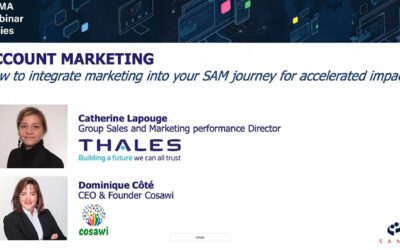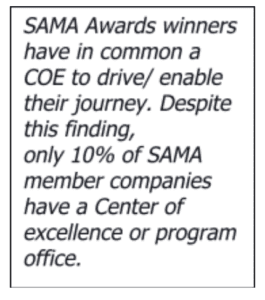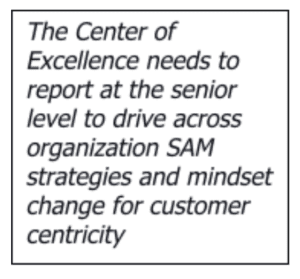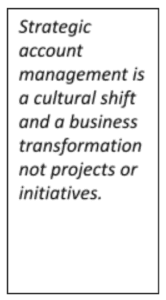How to integrate marketing into your SAM journey for accelerated impact” We know that Strategic Account Management is a team’s sport, yet marketing is often missing at the Strategic Account table. Listen on how one organisation, Thales, has integrated account...

Transformation through Agile Leadership
FROM EXECUTIVE SPONSORSHIP TO EXECUTIVE ENGAGEMENT
Dominique Côté
The idea of executive engagement implies
an accountable and engaged member of the account team, rather than a distant back- room player.
In our organization’s work, we see much confusion and lack of clarity on executive sponsorship, even when it is in place. Clarifying the executive sponsor role, behaviors (internally and externally) and expectations is critical to leverage the role as an accelerator and create executive accountability within the account team.
In the first article of this series on critical success factors for accelerating the SAM journey, we discussed the importance of establishing a SAM Center of Excellence (COE) to enable the SAM journey evolution, sustainability and agility. As a sequel, we would like to address the critical role of executive sponsorship, how it can impact the success of your strategic partnership when done well and, most importantly, best practices for doing so.
I remember being an executive sponsor myself in the corporate environment. During those years of leading SAM journeys, I was often frustrated by the lack of engagement among some of my fellow executive sponsor colleagues. For many of them, it was their belief that being an executive sponsor amounted to being a name on a slide and a lifeline when a critical issue or problem arose. We too often confuse strategic account sponsorship with corporate project sponsorship, where sponsorship is a way to escalate issues or decision-making when in need.
When done right, strategic account sponsorship begs to have a very different definition. I find it valuable to rebrand the concept from executive sponsorship to executive engagement. This name implies buy-in from the executive and the “be-in” mindset. The idea of executive engagement implies an accountable and engaged member of the account team, rather than a distant backroom player.
Strategic account management is a team sport and requires cross-functional, vertical level engagement and strong accountability. Executive sponsorship is undoubtedly critical to the team and is a key internal and customer account role. It must be part of the SAM structure that is put in place to enable, support and execute the SAM vision and strategy, enabling customer partnership, account revenue generation and achievement of objectives.
Below are the four key components that we see the best companies placing at the forefront of their efforts to accelerate executive sponsorship.
- Leading the organizational customer-centric culture
- Clearly defining the executive sponsor role
- Adapting corporate behaviors when working in the account
- Matching the right sponsor to each account
Let us take a deep dive into these four components.
1. Leading the organizational customer-centric culture
The executive sponsor has a role in creating and building the customer-centric culture for strategic account management. Customer-centricity doesn’t require a new business model but rather a new mindset. The executive sponsor has a critical role in creating and driving the needed shift in mindset and being accountable for its deployment and execution through employee and voice-of-customer feedback.

It is said that “culture eats strategy for breakfast” and is key to talent retention. Thus, influencing the organizational culture to become centered around the customer is one of the most critical roles of the executive sponsor. If we are asking our SAMs to bring their customers the best of what our entire enterprise has to offer, then we need the entire company to understand and be aligned around the customer. The SAM should be able to count on the help of the executive sponsor in amplifying the voice of the customer throughout the organization, particularly at the executive level.
It is challenging to get even simple things done in a complex, matrixed environment, and navigating our own organizations is one of the biggest barriers our customers say they face when working on establishing a strategic account management journey. Considering this, we note the natural tendency for SAMs to adopt a “do-it-yourself” way of working. One role of the executive sponsor, then, is to balance that can-do attitude – i.e., the ability to respond to continuous change – with the collaboration and alignment needed to create the value offer. Strategic account management is a team sport, and the sponsor needs to help to facilitate this team mindset.
2. Clearly defining the executive sponsor role
Recently, a client, who is a corporate executive, mentioned to me that he could sponsor eight to 10 accounts. We had worked with him throughout his company’s SAM journey and transformation. He said, “I already do it, so it should still be fine.” A flag went up immediately. It was clear that we needed to further define the executive sponsorship role and elaborate on its responsibilities. We also needed to make sure senior leaders are aware of these responsibilities to optimize their speed and impact.
A colleague from the SAMA Board of Directors, Noel Capon, recently wrote an article in Harvard Business Review, “When CEOs Make Sales Calls,”¹ in which he describes the impact of top management’s involvement in the customer relationship. He draws a parallel between executives and seagulls: “They fly in, make much noise, leave a mess and fly off.” Such behaviors can damage the customer relationship, the account’s share of wallet and the work’s success.
A good executive sponsor will not only open doors and initiate interactions but also will forge strong, trust-based relationships and will positively impact customers’ strategic objectives and growth. To be successful, the executive spon- sor needs to be matched with the appropriate account, understand his or her role and be open to feedback from the SAM on the role he or she should play. Executive sponsors need to leave their corporate behaviors behind and pivot to customer-facing behaviors.
A strategic account executive sponsor should:
- Serve as the voice of the customer internally and champion/advocate for the strategic account manager
- Eliminate internal barriers and advocate for resources to be allocated towards the portfolio of opportunities
- Stay informed on the account through an established strategic account process
- Contribute to, and have accountability for, the account plan
- Challenge account strategy and tactics
- Coach SAMs on business matters
- Participate in internal leadership and customer account meetings – and not only when “the house is on fire”
The executive sponsor should be familiar with the account and help expand the customer mapping, engagement and relationship. Their account interactions should be based on the account needs and plans, aligned with the SAM /orchestrator of the account in order to be additive when in front of the customer and bring value to the engagement and plans.
Sponsors are critical in these uncertain and transforma- tive times. To lead effectively, they must embrace change through agile leadership. Let us define what we mean by agile leadership:
1. VISION: Creating a vision is a way of aligning to a common direction. It is about having the ability to see a future that others do not see; creating and communicating a clear vision, mission and, most importantly, purpose; and having an optimistic, yet pragmatic, outlook that is solution oriented. Leaders need to be able to see the solution and the path to success ahead.
2. RESILIENCY: More and more, we hear about resiliency, i.e., the ability to bounce back and learn from adversity. In our current reality, this leadership skill is necessary to survive.
3. CHARACTER: Having character is the ability to do the right thing, to take a stand for ethics and values and think for the good of something bigger. It is about taking risks and staying on course, having the courage to continue the oath and being willing and accountable for mistakes.
4. EMPATHY; Empathy is the ability to put yourself in the shoes of your employees, colleagues and customers. It is about deeply and intentionally listening without judgment, really listening to the other’s perspective. Leaders must be able to care for the team member who is doing the job. Empathy can be used to listen as well as communicate. Caring must be embedded in both.
With these skills, agile leaders can help their teams thrive and stay focused on what is essential, while continuously monitoring the changing environment to transform their organization.
3. Adapting corporate behaviors when working in the account
Figure 2 shows the behaviors we need to consider when we take on the executive sponsor role.

The first behavior is acting with arrogance. Let’s be honest: To thrive in corporate politics, we climb the corporate ladder by being assertive. This can lead to arrogance and often an inflated ego. Although such behaviors may serve us well in the corporate environment, we need to pivot and leverage our humility while interacting with the customer. It is not the time to share everything we or the company has achieved. We need to focus on understanding the customer and helping the SAM deep dive in the customer environment and gain the insight and knowledge needed to deliver broader customer value.
Managing departments and people and leading strategies require strong decision-making and an authoritative presence. Leaders have different styles, but with increased seniority comes greater responsibility and accountability. When working with the account as an executive sponsor, we need to pivot to serving mode by helping the SAM see the fit between the customer needs and what we have, without over-committing. We must remain realistic and accountable and help the account team see the broader picture. We also must help them execute by removing roadblocks.
As executives working in our corporate environments, we are trained to solve problems. We are often the lifeline that guides the implementation teams and offers solutions to problems and issues. While this problem-solving role stays true internally, when we are in front of the customer, we need to suspend solving and focus on listening to understand deeper and better.
The world moves faster and faster, and with this, our impatience as executives has grown. How many projects never see the light of day due to lack of quick outcomes or a change in strategy? As an executive sponsor, we need to adapt to the customer’s pace and build opportunities and value offerings based on the customer’s speed, not ours. We need to align the project management, timelines and deliverables with the customer’s. The executive sponsor needs to represent this internally as well. Creating strategic customer value and building trust requires time. Strategic account management is mid-to-long-term focused. Creating strategic customer value and building trust requires time.
Finally, we should not assume that successful engagement between an executive sponsor and customer requires a fit at the title level. Matching the right executive to the right account requires finesse and the SAM’s input as the owner of the account relationship.
4. Matching the executive sponsor with the right account
The following are a few good practices to consider in matching the right executive sponsor to the right strategic account to drive revenue growth, provide agility, increase awareness for the strategic accounts and deepen the relationship.
1. You need to ensure that you have the sponsor’s time commitment. This needs to be a priority. We estimate a minimum of 10 to 12 hours per year. Obviously, this estimate can vary greatly depending on the scale, business, project and complexity of the strategic account. In addition, a monthly touchpoint with the SAM is important to coach them, stay abreast of the account and prepare for customer meetings.
2. The SAM needs to be part of the executive sponsor selection and be comfortable with the selected sponsor.
I suggest expanding your search beyond title and role, beyond commercial leaders. Procurement leaders, chief financial officers and other senior leaders can be great sponsors if the fit is right. We need to consider the person’s willingness and personality fit with the customer account. Variables such as culture, background, interests and hobbies can all be used to connect the best sponsor with the account.

We are fully aware that we often do not have all this information before matching. The point is that we need to leverage available information and go beyond conventional approaches based on roles and titles. The more you know about your strategic accounts, the better you can align your executive sponsor.
3. We need to think about the tenure of the executive sponsor. Strategic account management is about building trusted relationships. The executive sponsor can help expand these relationships, so a certain assignment length and continuity in the sponsorship commitment from the executive sponsor helps in the mid-to-long-term growth and penetration of the account, especially when co-creation is one of the relationship objectives.
Figure 3: Matching the right executive sponsor
Availability: Time commitment
Willingness: Desire to do this
Fit: Beyond title
Tenure: Commit to mid- to long term
What’s next?
Beyond creating a COE and rethinking executive sponsorship, it is time to bring back Marketing in a co-orchestrator role as account-based marketing (ABM) to help accelerate the strategic account management journey. Our third and final article in this series will define ABM and dive into its role as co-orchestrator of the value offering, the importance of Marketing to the SAM journey and the need to shift Marketing’s mindset from inside-out to outside-in. Look for it in an upcoming issue of Velocity. n
1 Noel Capon, When CEOs Make Sales Calls, Harvard Business Review, March-April 2021.
Dominique Côté brings 30 years of experience as an executive leader of commercial teams in global pharmaceutical and biotech organizations. Her consultancy work is focused on commercial excellence; executive leadership and coaching; KAM/SAM roadmaps and journeys; skills and process; and account-based marketing. She is the owner and founder of Cosawi and also a Principal at The Summit Group. She can be reached at [email protected] or through www.cosawi.com.
Download the Article HERE
About the Author
Dominique Côté brings 30 years of experience leading commercial teams in global pharmaceutical and biotech organizations. Her consultancy work is focused on Commercial Excellence, Executive coaching & leadership, KAM/SAM roadmaps & journeys, as well as Account based Marketing.
She is an accomplished international business leader, recognized as a chief architect of global account program journeys, leading corporate changes and cultural shifts for customer-centric innovation and patient value.
Dominique is a panelist and keynote speaker in Europe and the U.S. in the areas of commercial Excellence and Customer centricity. She writes and is published in journals like Journal of Sales Transformation, Velocity, and others on these topics.
Recent Posts
ABM Webinar with Thales
LinkedIn Live
What is ABM and what is the role of marketing on this new customer centric approach ? Listen to two thought leaders exchange on this topic interviewed by Arpedio Thoughtware is important upstream of platformware READ MORE
Transformation through Agile Leadership
The idea of executive engagement impliesan accountable and engaged member of the account team, rather than a distant back- room player. In our organization's work, we see much confusion and lack of clarity on executive sponsorship, even when it is in place....









 Establishing a COE is the number one most critical success factor for implementing an effective strategic account management business model. Despite this fact, only 10 percent of SAMA member companies have a COE, let alone an effective one.
Establishing a COE is the number one most critical success factor for implementing an effective strategic account management business model. Despite this fact, only 10 percent of SAMA member companies have a COE, let alone an effective one. 
 There is more than one way of doing this. Some organizations start this journey by creating a COE to support the SAM organization as a separate unit with a remit to test, iterate and pilot for speed. They then integrate this with the rest of the commercial group. Others will start with an already commercially integrated COE working across their business units.
There is more than one way of doing this. Some organizations start this journey by creating a COE to support the SAM organization as a separate unit with a remit to test, iterate and pilot for speed. They then integrate this with the rest of the commercial group. Others will start with an already commercially integrated COE working across their business units.  Clients tell us that, in most cases, their internal organizations are more challenging to navigate than their customer organizations and often present sthe most significant barriers to action and partnership with strategic accounts.
Clients tell us that, in most cases, their internal organizations are more challenging to navigate than their customer organizations and often present sthe most significant barriers to action and partnership with strategic accounts. 